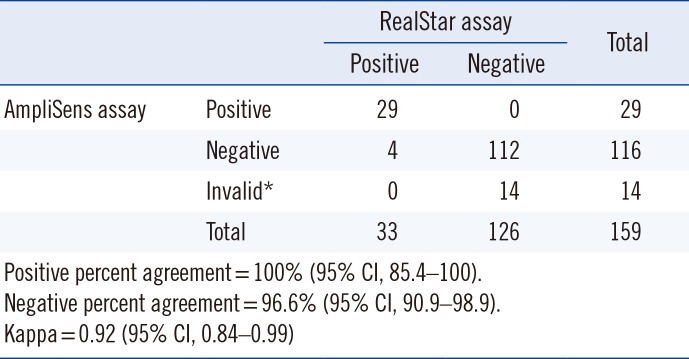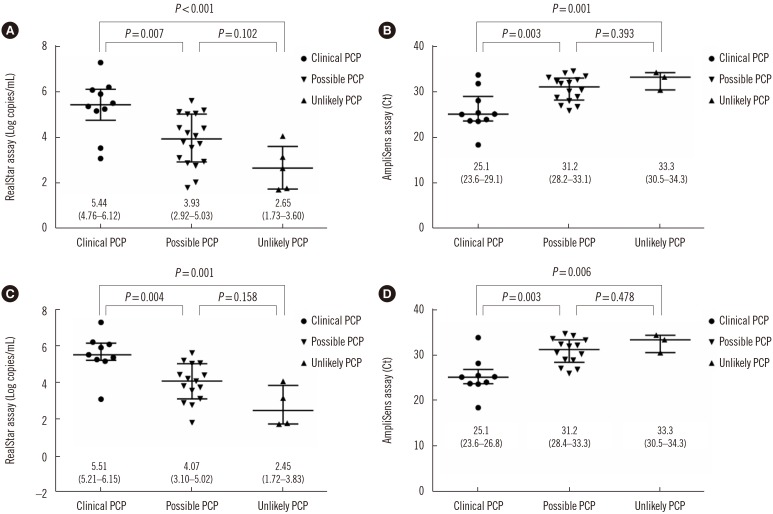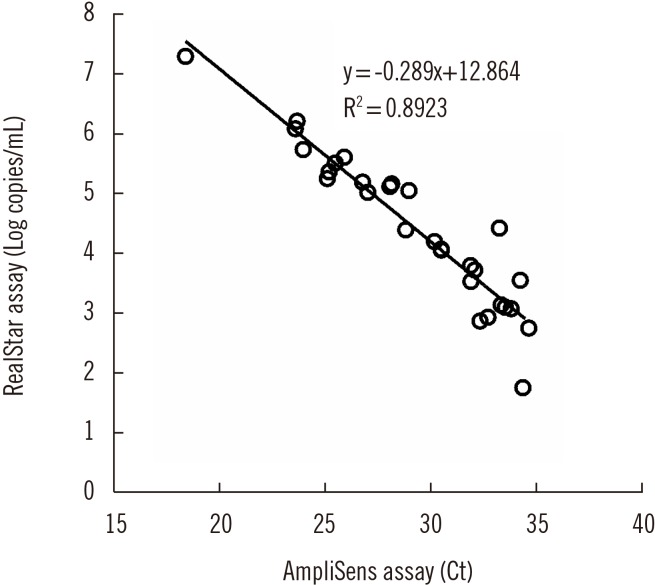1. Thomas CF Jr, Limper AH.
Pneumocystis pneumonia. N Engl J Med. 2004; 350:2487–2498. PMID:
15190141.
2. White PL, Backx M, Barnes RA. Diagnosis and management of
Pneumocystis jirovecii infection. Expert Rev Anti Infect Ther. 2017; 15:435–447. PMID:
28287010.
3. Alanio A, Hauser PM, Lagrou K, Melchers WJ, Helweg-Larsen J, Matos O, et al. ECIL guidelines for the diagnosis of
Pneumocystis jirovecii pneumonia in patients with haematological malignancies and stem cell transplant recipients. J Antimicrob Chemother. 2016; 71:2386–2396. PMID:
27550991.
4. Fauchier T, Hasseine L, Gari-Toussaint M, Casanova V, Marty PM, Pomares C. Detection of
Pneumocystis jirovecii by quantitative PCR to differentiate colonization and pneumonia in immunocompromised HIV-positive and HIV-negative patients. J Clin Microbiol. 2016; 54:1487–1495. PMID:
27008872.
5. Robert-Gangneux F, Belaz S, Revest M, Tattevin P, Jouneau S, Decaux O, et al. Diagnosis of
Pneumocystis jirovecii pneumonia in immunocompromised patients by real-time PCR: a 4-year prospective study. J Clin Microbiol. 2014; 52:3370–3376. PMID:
25009050.
6. Montesinos I, Brancart F, Schepers K, Jacobs F, Denis O, Delforge ML. Comparison of 2 real-time PCR assays for diagnosis of
Pneumocystis jirovecii pneumonia in human immunodeficiency virus (HIV) and non-HIV immunocompromised patients. Diagn Microbiol Infect Dis. 2015; 82:143–147. PMID:
25801778.
7. Botterel F, Cabaret O, Foulet F, Cordonnier C, Costa JM, Bretagne S. Clinical significance of quantifying
Pneumocystis jirovecii DNA by using real-time PCR in bronchoalveolar lavage fluid from immunocompromised patients. J Clin Microbiol. 2012; 50:227–231. PMID:
22162560.
8. Sasso M, Chastang-Dumas E, Bastide S, Alonso S, Lechiche C, Bourgeois N, et al. Performances of four real-time PCR assays for diagnosis of
Pneumocystis jirovecii pneumonia. J Clin Microbiol. 2016; 54:625–630. PMID:
26719435.
9. Montesinos I, Delforge ML, Ajjaham F, Brancart F, Hites M, Jacobs F, et al. Evaluation of a new commercial real-time PCR assay for diagnosis of
Pneumocystis jirovecii pneumonia and identification of dihydropteroate synthase (DHPS) mutations. Diagn Microbiol Infect Dis. 2017; 87:32–36. PMID:
27789058.
10. Guillaud-Saumur T, Nevez G, Bazire A, Virmaux M, Papon N, Le Gal S. Comparison of a commercial real-time PCR assay, RealCycler® PJIR kit, progenie molecular, to an in-house real-time PCR assay for the diagnosis of
Pneumocystis jirovecii infections. Diagn Microbiol Infect Dis. 2017; 87:335–337. PMID:
28143789.
11. McTaggart LR, Wengenack NL, Richardson SE. Validation of the MycAssay
Pneumocystis kit for detection of
Pneumocystis jirovecii in bronchoalveolar lavage specimens by comparison to a laboratory standard of direct immunofluorescence microscopy, real-time PCR, or conventional PCR. J Clin Microbiol. 2012; 50:1856–1859. PMID:
22422855.
12. Altona Diagnostics. Introductions for use: RealStar Pneumocystis jirovecii PCR Kit 1.0, 09/2016 [package insert]. Altona Diagnostics;2016.
13. Tia T, Putaporntip C, Kosuwin R, Kongpolprom N, Kawkitinarong K, Jongwutiwes S. A highly sensitive novel PCR assay for detection of
Pneumocystis jirovecii DNA in bronchoalveloar lavage specimens from immunocompromised patients. Clin Microbiol Infect. 2012; 18:598–603. PMID:
21951463.
14. Cooley L, Dendle C, Wolf J, Teh BW, Chen SC, Boutlis C, et al. Consensus guidelines for diagnosis, prophylaxis and management of
Pneumocystis jirovecii pneumonia in patients with haematological and solid malignancies, 2014. Intern Med J. 2014; 44:1350–1363. PMID:
25482745.
15. Lu Y, Ling G, Qiang C, Ming Q, Wu C, Wang K, et al. PCR diagnosis of
Pneumocystis pneumonia: a bivariate meta-analysis. J Clin Microbiol. 2011; 49:4361–4363. PMID:
22012008.
16. Fan LC, Lu HW, Cheng KB, Li HP, Xu JF. Evaluation of PCR in bronchoalveolar lavage fluid for diagnosis of
Pneumocystis jirovecii pneumonia: a bivariate meta-analysis and systematic review. PLoS One. 2013; 8:e73099. PMID:
24023814.
17. Mühlethaler K, Bögli-Stuber K, Wasmer S, von Garnier C, Dumont P, Rauch A, et al. Quantitative PCR to diagnose
Pneumocystis pneumonia in immunocompromised non-HIV patients. Eur Respir J. 2012; 39:971–978. PMID:
21920890.
18. Hauser PM, Bille J, Lass-Flörl C, Geltner C, Feldmesser M, Levi M, et al. Multicenter, prospective clinical evaluation of respiratory samples from subjects at risk for
Pneumocystis jirovecii infection by use of a commercial real-time PCR assay. J Clin Microbiol. 2011; 49:1872–1878. PMID:
21367988.
19. Maillet M, Maubon D, Brion JP, François P, Molina L, Stahl JP, et al.
Pneumocystis jirovecii (Pj) quantitative PCR to differentiate Pj pneumonia from Pj colonization in immunocompromised patients. Eur J Clin Microbiol Infect Dis. 2014; 33:331–336. PMID:
23990137.
20. Rudramurthy SM, Sharma M, Sharma M, Rawat P, Ghosh A, Venkatesan L, et al. Reliable differentiation of
Pneumocystis pneumonia from
Pneumocystis colonisation by quantification of Major Surface Glycoprotein gene using real-time polymerase chain reaction. Mycoses. 2018; 61:96–103. PMID:
28945326.
21. Louis M, Guitard J, Jodar M, Ancelle T, Magne D, Lascols O, et al. Impact of HIV infection status on interpretation of quantitative PCR for detection of
Pneumocystis jirovecii. J Clin Microbiol. 2015; 53:3870–3875. PMID:
26468505.
22. Matos O, Costa MC, Lundgren B, Caldeira L, Aguiar P, Antunes F. Effect of oral washes on the diagnosis of
Pneumocystis carinii pneumonia with a low parasite burden and on detection of organisms in subclinical infections. Eur J Clin Microbiol Infect Dis. 2001; 20:573–575. PMID:
11681438.
23. Samuel CM, Whitelaw A, Corcoran C, Morrow B, Hsiao NY, Zampoli M, et al. Improved detection of
Pneumocystis jirovecii in upper and lower respiratory tract specimens from children with suspected pneumocystis pneumonia using real-time PCR: a prospective study. BMC Infect Dis. 2011; 11:329. PMID:
22123076.
24. Helweg-Larsen J, Jensen JS, Benfield T, Svendsen UG, Lundgren JD, Lundgren B. Diagnostic use of PCR for detection of
Pneumocystis carinii in oral wash samples. J Clin Microbiol. 1998; 36:2068–2072. PMID:
9650964.
25. Chien JY, Liu CJ, Chuang PC, Lee TF, Huang YT, Liao CH, et al. Evaluation of the automated Becton Dickinson MAX real-time PCR platform for detection of
Pneumocystis jirovecii. Future Microbiol. 2017; 12:29–37. PMID:
27936923.
26. Alanio A, Desoubeaux G, Sarfati C, Hamane S, Bergeron A, Azoulay E, et al. Real-time PCR assay-based strategy for differentiation between active
Pneumocystis jirovecii pneumonia and colonization in immunocompromised patients. Clin Microbiol Infect. 2011; 17:1531–1537. PMID:
20946413.
27. Nummi M, Mannonen L, Puolakkainen M. Development of a multiplex real-time PCR assay for detection of
Mycoplasma pneumoniae,
Chlamydia pneumoniae and mutations associated with macrolide resistance in
Mycoplasma pneumoniae from respiratory clinical specimens. Springerplus. 2015; 4:684. PMID:
26576327.







 PDF
PDF ePub
ePub Citation
Citation Print
Print




 XML Download
XML Download